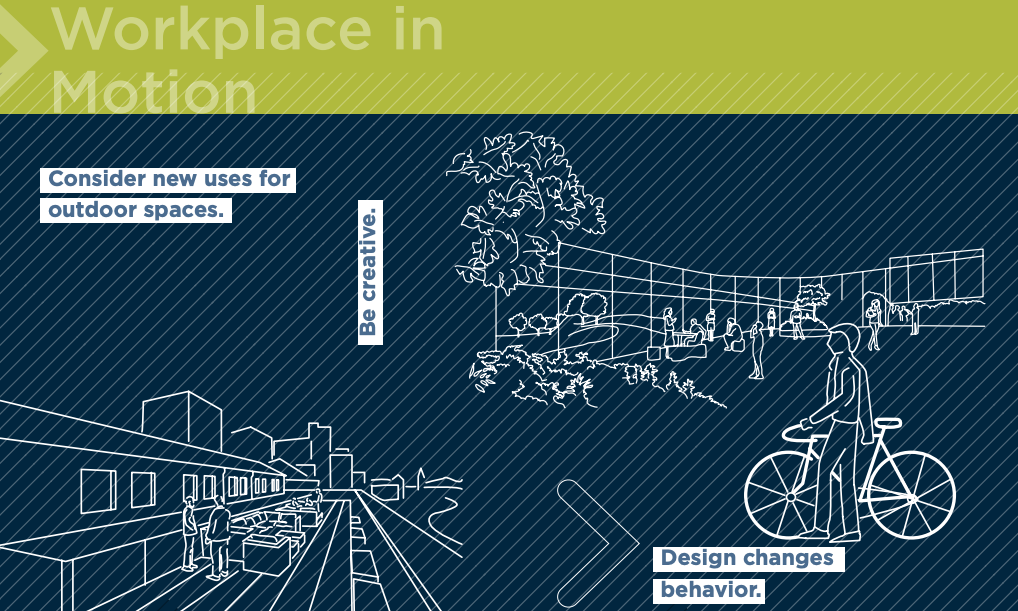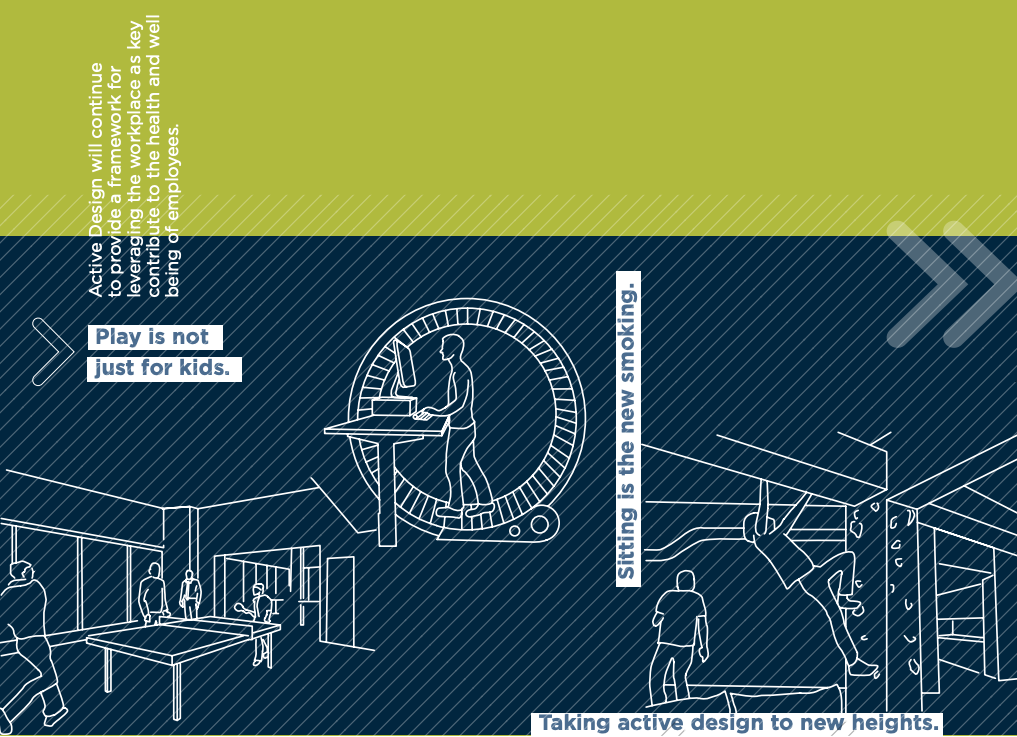Gone are the days of office workers figuratively chained to their desks.
In today’s winning workplaces, creating opportunities for physical activity and movement can have profound effects on office dynamics, company culture as well as the health and well-being of the employees.
As companies compete to recruit and retain top tier talent, innovative active design features such as treadmill workstations and climbing walls, can highlight a firm’s commitment to health and fitness, encourage social interaction, and bring a sense of fun and energy to the work place. Light physical activity also promotes blood flow that can aid in creativity and productivity, thus contributing to a company’s bottom line. On a macro-level, over the past three decades, obesity and related chronic diseases have skyrocketed in the United States while sitting has recently been declared “the new smoking”. The structure of the built environment is increasingly recognized as an important facilitator (or inhibitor) of a healthy lifestyle, given that where and how an individual works determines his or her opportunity to be physically active.
Active Design is a series of guidelines based on extensive research by an interdisciplinary team of government and private sector professionals to address obesity and chronic diseases as well as improve worker health and well being. This relatively new and innovative concept encompasses all aspects of design and space planning from projects small to large. Active design features are most effective when they reflect an organization’s values and brand. Some features integrate with sustainability efforts; others advance work-life balance goals; and still others are designed to improve mindfulness. Cushman & Wakefield’s West Region Sustainability Practice, led by Alex Spilger, has years of experience at helping companies design and create spaces that promote movement and physical activity in the workplaces. Below are several active design strategies we’ve implemented along the way – from the obvious to the more inventive.

Make staircases inviting.
Ascending and descending stairs is one of the best ways to promote walkability during the workday. Studies have shown that workers are much more likely to use stairs when the stairs are integrated as a design feature, rather than hidden away in an unfinished, windowless stairwell. Open staircases also promote sustainability because they reduce energy from elevator and escalator usage and often reduce lighting loads. Adobe’s LEED Platinum San Jose office earned LEED pilot credit PC-78, Design for Active Occupants, with inter-floor staircases integrated into the overall design, making use of natural light.
Locate shared functions on alternate floors.
Give employees reasons to use those open staircases more often by placing cafeterias, lounges and other commonly used resources on every second floor. This not only promotes walkability but increases the number of informal encounters between colleagues who work on different floors. Some companies have even considered placing lobbies and entrances on the second floor accessible by a staircase.
Shake up the traffic flow.
Companies are purposely designing offices so that restrooms, break areas, lounges, mailrooms and copy centers are a pleasant walking distance from desks. Active designs often require people to take different paths of travel throughout the office where there is no obvious ‘right’ way to traverse the space. Skype’s U.S. headquarters features casual meeting areas arranged in the center of the floor plate called ‘pods’ that encourage people to move through the space in less traditional ways. SF Travel provided space for a walkway between the window line and glass-enclosed conference room, allowing people to walk around the outside of the entire floor plan while retaining the benefits of natural light and views from the conference room.

Rooftop terraces with user-friendly amenities are increasingly common in high-rise apartments and hotels – why not in office buildings as well? The opportunity to get fresh area and enjoy cityscape views while meeting colleagues or doing solitary work offers the change of pace that can drive innovation. For example, Mozilla negotiated the use of the roof in their lease, turning the previously unused space into a lounge area that helps in recruiting employees.
As more companies integrate active design concepts into their space, leading-edge firms look for new ways to boost the “wow” factor that captures the attention of employees and visitors. Google, a recognized leader at using work spaces to recruit, retain and energize talented employees, continually looks for new ways to promote innovation. When designing their San Francisco office, Google incorporated this sloped terrace next to their micro-kitchen, modeled after Dolores Park, to provide people a multi-dimensional space where they can move, sit and connect in different ways, all while overlooking the exterior courtyard and enjoying a healthy snack or cup of tea. Bicycle storage within office buildings often gets located in the basement, garage or a storage closet. In aligning with the principles of Active Design, more of our clients are integrating bicycle storage as a prominent design feature, placing the bike racks in the lobby or allowing employees to suspend bikes from the ceiling. Using bikes as part of a design feature helps give the office space a fun, active and outdoorsy vibe. The bike racks located in the lobby of Living Social provide a visual form of encouragement for employees to bike to work, further promoting the firm’s sustainability efforts.

Incorporating ‘play’ into an office space has shown to promote relaxation and spur creativity among employees. For many, play is considered as much a part of being human as eating and sleeping; some firms go so far as to require it as part of their workday on a regular basis. At Google’s Real Estate and Workplace Services Headquarters in Mountain View, employees, managers included, hold regular ping-pong tournaments, providing employees an opportunity for exercise while connecting with colleagues on a different level. Within many firms and industries, ‘work’ is considered a verb, not a noun; however, it often still requires us to be present in a physical office space, working in front of a computer. Providing employees with greater control over their office workstations can be a feature of both an ergonomics program as well as active design. Adjustable height sit-stand desks have become the norm for most companies. Some firms have taken things to a new level, even employing ‘walking desks’.
As the Active Design movement continues to gain momentum, innovative start-ups are taking the concept to new levels, challenging the notions of what is possible within an office work environment. Where one firm might see an inconveniently located interior column, another sees a chance to climb! Active Design, as a movement, is still in its infancy. With the influx of healthsavvy millenials in the workplace and the growth of health apps we do everything from count calories, measure steps and monitor heart rate, the interest in creating truly ‘healthy’ workplaces will surely continue to grow. In correlation, Active Design will continue to provide a framework for leveraging the workplace as key contributor to the health and well being of employees. The limits of what are possible with office design and the ability to use physical space to positively impact human health are not only being redefined, but revolutionized – one office space at a time.
This article is written by Alex Spigler, LEED AP Senior Vice President, Sustainability Services, Cushman & Wakefield
